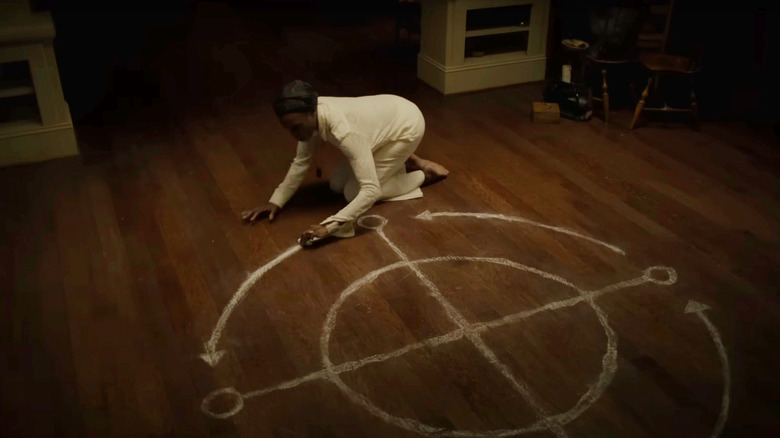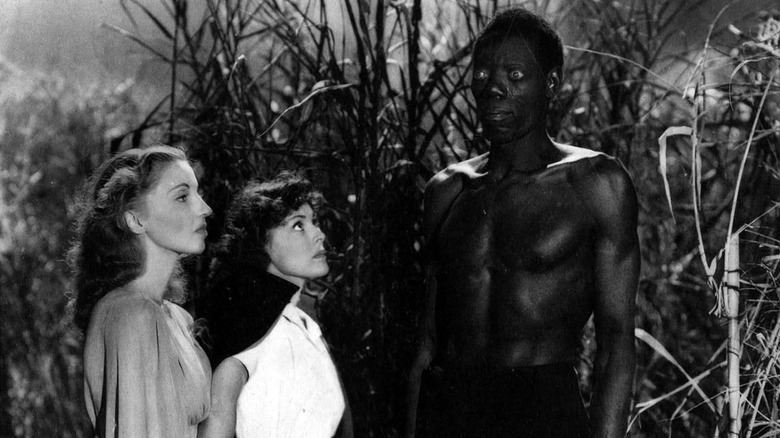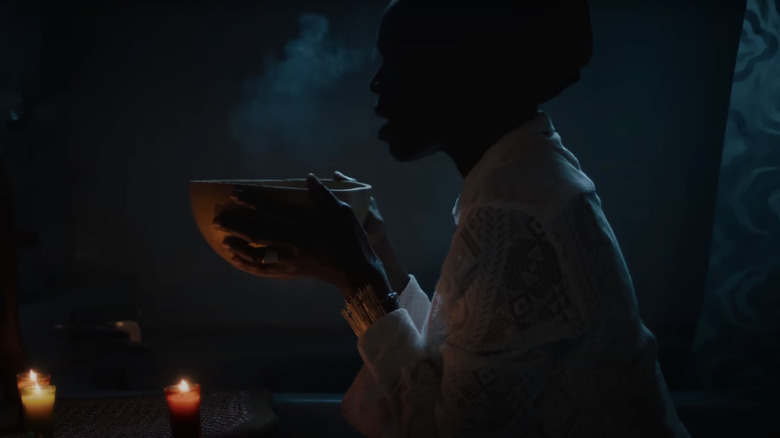Why The Exorcist: Believer Looks Beyond The Catholic Church To Fight Its Demons [Exclusive]
This article contains mild spoilers for "The Exorcist: Believer."
In William Friedkin's 1973 adaptation of William Peter Blatty's "The Exorcist," the film opens not on the possession of 12-year-old Regan MacNeil, but on Catholic priest and archaeologist Father Merrin (Max von Sydow), who is on a dig in Northern Iraq. He comes across a medallion of Saint Joseph, as well as an idol representing the demon Pazuzu. Fans of the film "The Exorcist II: The Heretic" will know that this is representative of the demon that will later possess Regan. According to Babylonian and Assyrian myth, Pazuzu is a wind demon, and his presence in the opening indicates that Merrin has dealt with Pazuzu before.
But with this desert setting, this scene also implies that there's something foreign — other, about this statue and medallion. Almost as if the intrusion of artifacts from the Middle East is truly responsible for the Hell that is to come. And yet, just about every religion or belief system addresses the existence of evil, and more importantly, how to rid them from our lives and bodies. This is something that the director of "The Exorcist: Believer," David Gordon Green, wanted to capture in his direct sequel to the original film.
"In doing our research, if you open up any doctrine, anything from Pentecostal to Wiccan to Rootwork to so many others ... I have a book, a diary of a Baptist exorcist, and things that I just didn't know were out there because of my lack of knowledge in that world of demonology and the world of ceremony and rituals [in] so many cultures," Green told me in an exclusive interview. "So I tried to take a handful of things that I can point to — can't do all of them, but almost every religion, like Chris [MacNeil] says in the movie, almost every religion has a ritual."
Horror's complicated legacy with non-Christian religions
Evangelical Americans often forget that religions exist outside of their own belief system, and they often have more in common with other religions than they differ. But when it comes to the horror genre, the Christian faith has a stranglehold on the stories that are told, frequently treating other religions as less powerful at best, and dangerous at worst — especially in its depiction of African spirituality or religion.
Some of the earliest American horror films, like "I Walked With a Zombie," utilized zombies as almost an extension of minstrelsy, weaponizing the ignorance of white filmmakers and the predominantly white audiences with African religions like Voudou. The terror of "White Zombie" was not that a man had used a Black religion against its own people to turn them into undead slaves, it was that the white Madeleine Short was being turned into a zombie.
"So I wanted to point to a few that I don't think had been acknowledged, in particular, Rootwork or Hoodoo culture," said Green. "In the opening of the film, it's a real Voudou priestess, a Haitian Voudou priestess giving a real blessing of protection. And I wanted to bring the beauty and authenticity to some of the religious attributes of this that I think can be condescending in film or used in exploitative ways that I don't feel represent the intentions behind those rituals."
Indeed, much of the representation of Voudou or other African religions in horror are dripping with racism. Even horror maestro Wes Craven entered this arena with "The Serpent and the Rainbow," where Bill Pullman essentially spends an entire movie in the "white guy enters 'scary ethnic' culture" trope. And lest we forget the prevalence of "ancient Indian burial grounds" as a source of terror in horror films where indigenous practices or the remains of genocide are bastardized to tell stories of ghosts and resurrection to unsettle the white status quo.
Does The Exorcist: Believer work?
Making movies is hard, making movies that are trying to contend with decades of offensive portrayals is even harder, and after speaking with Green about his intentions with "The Exorcist: Believer," it's hard to be harsh on the film. Then again, the road to Hell is paved with good intentions. The climatic exorcism features African priestess Dr. Beehibe (Okwui Okpokwasili), who brings root magic to assist with cleaning the girls of the demonic presence. She's a figure I wish we saw more of, and honestly, could have done without any of the Christian/Catholic figures, although I understand why they were there. It is so clear that the script from Green and Peter Sattler (from a story by Green, Danny McBride, and Scott Teems) is trying to redirect the usual focus of exorcism stories, respectfully decentering white male saviors.
Unfortunately, because we're not given a whole lot of time with Dr. Beehibe, she feels wholly underutilized. It's a lot like the big team-up scene in "Avengers: Endgame," where the allure is "Hey, look at that hero!" instead of actually exploring what they bring to the table. Filmmakers can get away with surface-level depictions of Christians and Catholics in American cinema because even the most secular of secular people have a familiarity with the practices due to cultural osmosis. For other religions, we need to go deeper. Green's intentions were in the right place, and the research was thorough — it's a shame the film doesn't reflect that passion.
Here's hoping that as the trilogy moves forward, Green can completely decenter Christian practices and fulfill the untapped potential of this first film.
"The Exorcist: Believer" is now playing in theaters everywhere.


